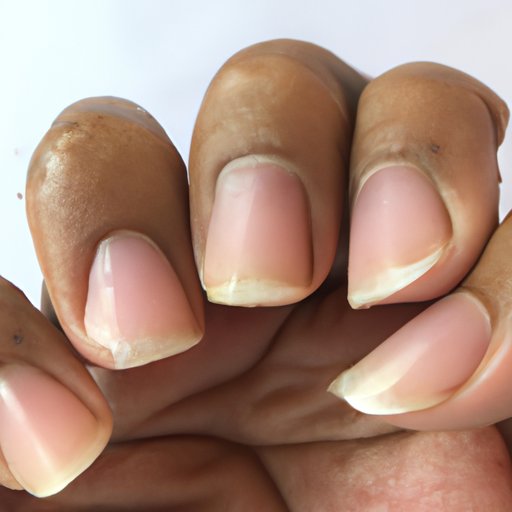Introduction
Nail ridges are lines that run horizontally across the nails and can affect both fingernails and toenails. They can range from mild to severe, and in some cases, they may be accompanied by discoloration and texture changes. In most cases, nail ridges are harmless and will not cause any pain or discomfort. However, it is still important to understand what causes nail ridges, so you can take steps to prevent them and seek treatment if needed.
Analyzing the Risk Factors of Nail Ridges
When it comes to understanding what causes nail ridges, there are several potential risk factors to consider, including age, genetics, diet, and hormonal changes. Let’s take a closer look at each one.
Age
As we age, our nails naturally become thinner and weaker, making them more prone to developing ridges. In addition, the blood flow to the nail bed decreases as we age, which can also lead to the formation of ridges.
Genetics
Genetics can also play a role in the development of ridges on nails. If someone in your family has a genetic disorder that affects the nails, such as psoriasis or eczema, you may be more likely to develop nail ridges.
Diet
Your diet can also have an effect on your nails, and a lack of certain nutrients in your diet can lead to nail ridges. Nutrient deficiencies, particularly those involving vitamin A, iron, and zinc, can increase the risk of developing ridges on the nails.
Hormonal Changes
Hormonal changes, such as those that occur during pregnancy or menopause, can also influence the development of nail ridges. In addition, thyroid issues can also increase the likelihood of developing ridges on the nails.

Investigating Common Causes of Ridge Lines on Nails
In addition to the risk factors mentioned above, there are also several common causes of nail ridges, including injury, infection, eczema, and psoriasis.
Injury
If you injure your nail, either accidentally or intentionally, you may experience ridge lines on the nail. This is because the nail is trying to repair itself and form a new layer over the damaged area.
Infection
Infections, such as fungal infections, can also cause ridges to form on the nails. In this case, the ridges may be accompanied by other symptoms, such as discoloration, peeling, and thickness.
Eczema
Eczema, also known as atopic dermatitis, is a chronic skin condition that can cause nail ridges. The ridges may be accompanied by other symptoms, such as dryness, redness, and flaking of the skin.
Psoriasis
Psoriasis is another skin condition that can cause nail ridges, as well as other symptoms, such as yellowish-orange discoloration and thickening of the nail plate.
Examining the Link Between Nail Health and Nail Ridges
The health of your nails is also related to the development of nail ridges. Dryness, brittleness, and weak nails can all increase the likelihood of developing ridges on the nails.

Exploring the Relationship Between Diet and Nail Ridges
Your diet can also play a role in the development of nail ridges. Nutrient deficiencies, such as deficiencies in vitamin A, iron, and zinc, can all increase the risk of developing ridges on the nails.

Exploring the Link Between Aging and Nail Ridges
As we age, the nail plate begins to thin, making it more susceptible to developing ridges. In addition, the reduced blood flow to the nail bed can also contribute to the formation of ridges.

Uncovering the Relationship Between Hormonal Changes and Nail Ridges
Hormonal changes, such as those that occur during pregnancy or menopause, can also lead to the development of nail ridges. In addition, thyroid issues can also increase the risk of developing ridges on the nails.
Assessing the Role of Genetics in Nail Ridges
Genetics can also play a role in the development of nail ridges. Inheriting a genetic disorder that affects the nails, such as psoriasis or eczema, can increase the risk of developing ridges on the nails.
Conclusion
Nail ridges can affect both fingernails and toenails and are usually harmless. However, it is still important to understand what causes nail ridges so you can take steps to prevent them and seek treatment if needed. Age, genetics, diet, and hormonal changes can all influence the development of nail ridges, as can injury, infection, eczema, and psoriasis. To reduce your risk of developing nail ridges, make sure to eat a balanced diet and keep your nails moisturized. If you are experiencing severe nail ridges, talk to your doctor for further evaluation and treatment.


